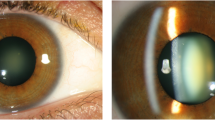Abstract
We prospectively evaluated for the presence of new retinal tears 60 eyes of 60 patients who developed recurrent retinal detachment complicated by proliferative vitreoretinopathy (PVR) after surgery for primary rhegmatogenous retinal detachment. New retinal tears associated with the development or recurrence of postoperative PVR were disclosed in 27 eyes (45%). New tears were categorized into two distinct groups: (1) peripheral new tears and (2) posterior new tears. Peripheral new tears were disclosed in 11 eyes. They were invariably located at the posterior edge of the vitreous base and showed a prevalence in the inferior quadrants. The prognosis for permanent retinal reattachment after reoperation was not influenced by the presence of peripheral new tears. Posterior new tears were disclosed in 19 eyes. They were located in the midperiphery or close to the posterior pole. They were more frequent in grade D PVR (57.7%) compared with grade C PVR (11.7%) (P< 0.01). Posterior new tears were associated with a poor prognosis. In grade D PVR the anatomic success rate following repeated surgery was only 13.3% (2/15 eyes), whereas all eyes with grade D PVR and no posterior new tears were successfully reattached (P<0.001). Failures to reattach the retina were related to recurrent PVR. It is concluded that the development of posterior new tears in postoperative PVR reflects a severe and active PVR process.
Similar content being viewed by others
References
Bonnet M (1988) The development of severe proliferative vitreoretinopathy after retinal detachment surgery. Grade B: a determining risk factor. Graefe's Arch Clin Exp Ophthalmol 226:201–205
Bonnet M (1989) Microsurgery of retinal detachment, 2nd edn. Field and Wood, Philadelphia, pp 238–239, 241–252
Bonnet M (1990) Vitrectomy in grade B proliferative vitreoretinopathy. Proc XVIIth congress of the Club Jules Gonin, Lausanne, September 2–6, 1990
Bonnet M, Santamaria E, Mouche J (1987) Intraoperative use of pure perfluoropropane gas in the management of proliferative vitreoretinopathy. Graefe's Arch Clin Exp Ophthalmol 225:299–302
Dreyer RF (1986) Sequential retinal tears attributed to intraocular gas. Am J Ophthalmol 102:276–278
Poliner LS, Grand MG, Schoch LH, et al (1987) New retinal detachment after pneumatic retinopexy. Ophthalmology 94:315–318
Retina Society Terminology Committee (1983) The classification of retinal detachment with proliferative vitreoretinopathy. Ophthalmology 90:121–125
Author information
Authors and Affiliations
Additional information
Correspondence to: M. Bonnet
Rights and permissions
About this article
Cite this article
Fleury, J., Bonnet, M. Prognostic value of new retinal tears associated with the development of postoperative proliferative vitreoretinopathy. Graefe's Arch Clin Exp Ophthalmol 230, 459–462 (1992). https://doi.org/10.1007/BF00175934
Received:
Issue Date:
DOI: https://doi.org/10.1007/BF00175934




